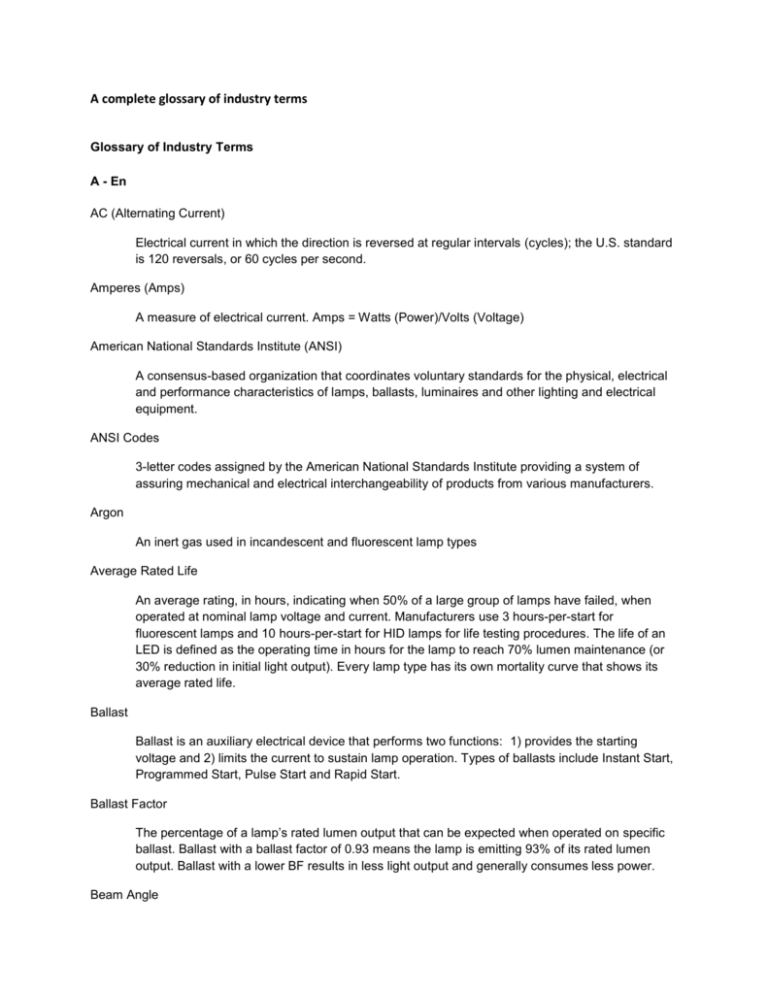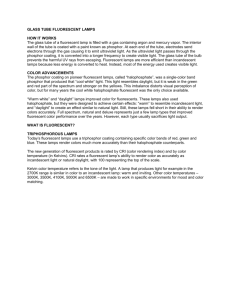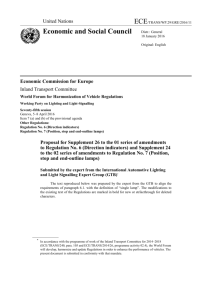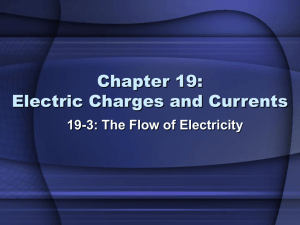ozone discharge
advertisement

A complete glossary of industry terms Glossary of Industry Terms A - En AC (Alternating Current) Electrical current in which the direction is reversed at regular intervals (cycles); the U.S. standard is 120 reversals, or 60 cycles per second. Amperes (Amps) A measure of electrical current. Amps = Watts (Power)/Volts (Voltage) American National Standards Institute (ANSI) A consensus-based organization that coordinates voluntary standards for the physical, electrical and performance characteristics of lamps, ballasts, luminaires and other lighting and electrical equipment. ANSI Codes 3-letter codes assigned by the American National Standards Institute providing a system of assuring mechanical and electrical interchangeability of products from various manufacturers. Argon An inert gas used in incandescent and fluorescent lamp types Average Rated Life An average rating, in hours, indicating when 50% of a large group of lamps have failed, when operated at nominal lamp voltage and current. Manufacturers use 3 hours-per-start for fluorescent lamps and 10 hours-per-start for HID lamps for life testing procedures. The life of an LED is defined as the operating time in hours for the lamp to reach 70% lumen maintenance (or 30% reduction in initial light output). Every lamp type has its own mortality curve that shows its average rated life. Ballast Ballast is an auxiliary electrical device that performs two functions: 1) provides the starting voltage and 2) limits the current to sustain lamp operation. Types of ballasts include Instant Start, Programmed Start, Pulse Start and Rapid Start. Ballast Factor The percentage of a lamp’s rated lumen output that can be expected when operated on specific ballast. Ballast with a ballast factor of 0.93 means the lamp is emitting 93% of its rated lumen output. Ballast with a lower BF results in less light output and generally consumes less power. Beam Angle The angle of the light pattern from the beam’s center out to the point where the luminous intensity (brightness) is half that of the maximum intensity (CBCP - center beam candle power). Burn Position The position in which a lamp is designed to operate in, applying mainly to High Intensity Discharge lamps. Capacitor – A device in ballast that stores electrical energy. Often used for power factor correction and lamp regulation. CE (Conformité Européene) CE marking on a product is a manufacturer's declaration that the product complies with the requirements of the relevant European health, safety and environmental protection legislations. Candela (cd) The measure of luminous intensity of a light source in a given direction, regardless of distance. Center Beam Candlepower (CBCP) The luminous intensity measured at the center of the beam of a reflector lamp. Measured in candelas. Chromaticity – A measure to identifying the color of a light source, typically expressed as (x, y) coordinates on a chromaticity chart. Color Corrected Refers to a lamp with a special phosphor or coating giving it a color rendering profile similar to natural daylight. Color Rendering Index (CRI) Based on a scale of 100, a lamp’s ability to render an object’s true colors. Correlated Color Temperature (CCT) A numerical measurement of the color appearance of a light source measured in degrees Kelvin (K). It also refers to the way color groups are perceived (psychological impact of lighting). A low color temperature implies warmer color (more yellow/red) light while high color temperature implies a cooler light (more blue). Current A measurement of the rate of flow of electricity, expressed in amperes (A). DC (Direct Current) An electrical current and distribution by which electricity flows in one direction through the conductor. Battery operated systems are a typical example of DC applications. Dichroic Reflector A reflector (or filter) that reflects the visible light region of the spectrum but allows the other region(s) (heat) to pass through the back of the lamp. A lamp with a dichroic reflector will have a "cool beam" since most of the heat has been dissipated. Discharge Lamp A light source that produces light by passing a current between electrodes through a vapor or gas. Examples include fluorescent and high intensity discharge lamps. Department of Energy Governmental department whose mission is to advance energy technology and promote related innovation in the United States. www.energy.gov Driver A self-contained power supply with outputs that match the electrical characteristics of the lamp. It is similar to ballast and is used to power illumination sources. Efficacy A measurement of the effectiveness of a light source in converting electrical energy into lumens of visible light. Expressed as lumens-per-watt (LPW), this measure gives more focus on the yellow region of the spectrum and less to the blue and red region where the human eye is not as sensitive. Efficiency The fraction of electrical energy converted to light, i.e. watts of visible light produced for each watt of electrical power with no concern about the wavelength where the energy is being radiated. The efficiency of a luminaire (or fixture) is the percentage of the lamp lumens that actually come out of the fixture. Electrical Testing Laboratory (ETL) Independent testing laboratory that performs ballast tests and certifies performance data. Electromagnetic Spectrum A flow of electric and magnetic radiation that is characterized by wavelength or frequency. Visible light is a small part of the electromagnetic spectrum in the region from about 380 nanometers (violet) to 770 nanometers (red) by wavelength. Environmental Protection Agency The EPA was formed to protect human health and the environment. It implements environmental laws written by Congress by developing regulations and their enforcement. www.epa.gov Energy Independence and Security Act (EISA) 2007 The Energy Independence and Security Act of 2007 was signed into law on December 19, 2007. This act builds on the progress made by the Energy Policy Act of 2005 (EPAct) by setting out an energy strategy for the 21st century. It is a major step toward reducing our dependence on oil and so increasing our energy security and making our country cleaner for future generations. An update to the act was issued in 2009 for incandescent reflector lamps and general service fluorescent lamps. Energy Star Energy Star is a joint program of the U.S. Environmental Protection Agency and the U.S. Department of Energy to promote lowering costs of energy and the protection of the environment through the use of energy efficient products and practices. www.energystar.gov Energy Policy Act (EPAct) Energy legislation passed by Congress in 1992 and updated again in 2005, mandating labeling and minimum efficiency requirements for many commonly used incandescent and fluorescent lamps. Note that the Energy Independence and Security Act of 2007 (EISA 2007) and Executive Order (E.O.) 13423 were issued subsequent to the passage of EPAct 2005. See Energy Independence and Security Act (EISA) 2007. Fe - Na Federal Communications Commission (FCC) The U. S. Federal agency that regulates emissions in the radio frequency portion of the electromagnetic spectrum. Part 18 of the FCC rules specifies electromagnetic interference (EMI) from lighting devices operating at frequencies greater than 9 kilohertz (kHz). Typical electronically ballasted compact fluorescent lamps operate in the 24 - 100 kHz range. Field Angle The angular dimension of the cone of light from reflectorized lamps (such as R and PAR types) encompassing the central part of the beam out to the point where the intensity is 10% of maximum. See Beam Angle. Filament Wire used in incandescent lamps. Filaments are usually made of tungsten and often coiled. Filaments emit light when heated by an electrical current. Foot candle (fc) The unit of measure for the density of light on a surface. One foot candle is equal to one lumen per square foot (lm/ft2). One foot candle = 10.674 lux. Glare An interference with visual perception caused by an uncomfortably bright light source or reflection within one’s field of view; sometimes referred to as visual noise. Halogen A group of inert gases, particularly Bromine, which are used to reduce the amount of tungsten that plates the interior wall of the lamp. At high temperatures, the halogen reacts with the tungsten and forms tungsten bromide, freeing tungsten from the wall and re-depositing it onto the filament. Halogen Cycle A regenerative cycle of tungsten and halogen atoms, preventing blackening of the lamp envelope during over life of the lamp. See Halogen. High Lumen Lamps that operate with higher lumens (brightness) than the standard model. High Output Fluorescent (HO) Fluorescent lamps designed to be used with an 800 milliampere ballast. These lamps can operate at low temperatures (down to 0oF) and are still able produce high light levels. Illuminance The total density of visible light - from all directions - illuminating, falling on or incident to, a surface. One lumen per square foot equals one foot candle (lm/ft2); one lumen per square meter equals one lux (lm/m2). Initial Lumens The measured luminous output of a new light source. Instant-Start A type of fluorescent lamp-ballast circuit that is designed to start fluorescent lamps immediately as the power is applied. Integrated Circuit (IC) IC-based CFLs operate by controlling the voltage and current by adjusting the output frequency. This also provides stable operation of the CFL. Controlling the current produces less stress on the cathode and electronic components. This results in longer life, smoother dimming, and less noise. International Dark Sky Association (IDA) IDA is the recognized authority on light pollution. The IDA, founded in 1988, is the first organization to call attention to the hazards of light pollution. www. darksky.org IP65 The protection of enclosures against ingress of dirt or water is defined in IEC529 (BSEN60529:1991). The first digit in the rating is the protection against contact and foreign bodies. The second digit is the water protection factor. IP65 indicates a lamp is totally protected against dust and protected against low pressure jets of water from all directions, though limited ingress is permitted. Kelvin The Kelvin unit is the basis of all lighting color temperature measurement. Kelvin is the unit of measure used to indicate the overall color of the light produced from a source. Also see correlated color temperature. Kilowatt (kW) The measure of electrical power equal to 1000 watts. Kilowatt Hour (kWh) The measure of electrical energy from which electricity billing is determined. For example, at the rate of $0.11 per kWh, a 100 watt lamp operating for 1000 hours will cost $11.00 (100 x 1000/1000 = 100 kWh x .11 = $11.00) Krypton A noble gas used in lamps. Typically, Krypton lamps offer brighter, whiter light than incandescent. Lamp The lighting industry term for a complete light source package, usually referred to by consumers as a "bulb". Light Center Length (LCL) The distance between the center of the filament, or arc tube, and a reference plane - usually the bottom of the lamp base. Light Radiant energy that stimulates the sense of sight. The "visible" part of the electromagnetic spectrum from 380-770 nm. Light Pollution Light which is present in areas where it is not needed, thereby interfering with some visual act. Light pollution directed or reflected into the sky creates a "dome" of wasted light making it difficult to see stars above cities, for example. Light Trespass (Spill Light) Light that is not aimed properly or shielded effectively can spill out at into areas where it’s unwanted. It can be directed towards drivers, pedestrians or neighbors. It is distracting and can be disabling. Line Voltage See voltage. Lumen (lm) The measure of luminous flux or quantity of light emitted by a source. Lumen Depreciation The gradual decline in output from a light source over time due to filament deterioration and bulb darkening. Lumen Maintenance A measurement of how a lamp maintains its light output over time. Lumens per Watt (LPW) A measure of the efficacy (efficiency) of a light source, achieved by dividing lumens produced by watts consumed. Luminaire A complete lighting unit consisting of a lamp(s), ballast(s) as required to distribute the light, the ability to position and protect the lamps and connect them to the power supply. Often referred to as a fixture. Luminance A photometric measure of the brightness of a surface as seen by the observer, measured in candelas per square meter (cd/m2). Luminous Efficacy The light output (lumens) of a light source divided by the total power input (watts) to that source, expressed as lumens per watt. Lux (lx) A unit of luminance (light) falling onto a surface. One lux equals one lumen per square meter; ten lux is approximately one foot candle. Lighting Facts Label The Federal Trade Commission (FTC) mandated a standard lighting facts label be included on all bulbs intended for general service use. Packaging for standard base LEDs, CFLs and household incandescents will show this new two-part label from now on, effective January 1st, 2012. Maximum Overall Length (M.O.L.) The end-to-end measurement of a lamp, in inches or millimeters. Mean Lumens The measured luminous output of a light source at: 40% of lamp life for fluorescent and metal halide lamps, 50% of lamp life for mercury, high-pressure sodium and incandescent lamps. Maximum of Diameter (M.O.D.) The measurement of a lamp’s diameter, in inches or millimeters. Mercury Metallic element, chemical symbol Hg, atomic number 80. Mercury is the only elemental metal that is liquid at ordinary temperatures, with a freezing point of -38 ºF (-39 ºC) and a boiling point of 674 ºF (356.9 ºC). Mercury is used in compact fluorescent, fluorescent and HID lamps. Modified Spectrum Light sources that utilize neodymium glass or coating (composed of rare earth elements) to simulate true daylight. This glass or coating filters out the yellow light produced by standard incandescent lamps. Nanometer A unit of wavelength equal to one billionth of a meter. Ne - Z Neodymium A rare earth element used to produce modified spectrum (full spectrum) incandescent lamps, also known as daylight or natural light. Using a colored glass shell, they filter out the yellow light produced by standard incandescent lamps. Nominal Length A measurement for fluorescent lamp length based on the length of the lamp plus an allowance for the luminaire's lamp holders. Open Fixture Rated Lamps that are approved for burning in open fixtures, as opposed to enclosed fixtures. PAR Lamp A PAR lamp (parabolic aluminized reflector), which may use an incandescent filament, a halogen filament tube or a HID arc tube, is a precision pressed-glass reflector lamp. PAR lamps rely on the internal reflector and prisms in the lens to control the light beam. PAR lamps are also available using LED technology, where the lens is used to control the beam. Phosphor An inorganic chemical compound processed into a powder which is deposited on the inner glass surface of fluorescent tubes, CFL's, LED's and some mercury and metal-halide lamp bulbs. Phosphors are designed to absorb short wavelength ultraviolet radiation and then transform it into visible light. Photometry The measurement of light and related quantities. Power Factor (PF) Measurement of the relationship between the AC source voltage and current. Power factors can range from 0 to 1.0, with 1.0 being ideal. The power factor is sometimes expressed as a percent. Incandescent lamps have power factors close to 1.0 because they are simple "resistive" loads. The power factor of a fluorescent and HID lamp system is determined by the ballast used. A high power factor usually indicates a rating of 0.9 or greater. Pre-heat Lamp A fluorescent lamp in which the filament must be heated by use of a starter prior to the arc being created. These lamps are usually operated with electromagnetic ballasts. Programmed Rapid Start A fluorescent lamp-ballast circuit using a custom integrated circuit (IC) which monitors lamp and ballast conditions to ensure optimal system lighting performance. PS ballasts heat the lamp cathodes to 700oC prior to lamp ignition. This puts the least stress on the lamp electrodes, resulting in maximum lamp life regardless of the number of starts. Programmed-start ballasts are usually wired in series. Pulse Start A fluorescent lamp-ballast circuit that is designed with an igniter which ignites the arc tube, so these bulbs have no need for the starter electrode. Pulse start lamps are typically more efficient than their standard counterparts. Rapid Start A fluorescent lamp-ballast circuit which utilizes continuous cathode heating while the system is energized which starts and maintains lamp light output at efficient levels. Rapid start ballasts could be either electromagnetic, electronic or of hybrid designs. Full-range fluorescent lamp dimming is only possible with rapid start systems. Rated Lamp Life The length of time between first use and the point when 50% of lamps died (no longer operating) in a statistically large sample. RoHS RoHS is a European directive and stands for the Restriction on Hazardous Substances. The RoHS regulation restricts the use of certain hazardous substances in electrical and electronic equipment. Self-Ballasted Lamps A discharge lamp with an integral ballasting device which allows the lamp to be directly connected to a socket providing line voltage. Spectral Power Distribution (SPD) A graph illustrating the radiant power emitted by a light source as a function of wavelength. SPDs provide a visual profile (much like a finger print) of the color characteristics of the source throughout the visible part of the spectrum. Starter An electronic module or device used to assist in starting a discharge lamp, typically by providing a high-voltage surge. Starting Temperature (Minimum) The minimum ambient temperature at which a lamp will start reliably. Task Lighting Lighting designed for a specific task which requires higher light levels; requirements vary according to the proximity to that task and the level of detail. Total Harmonic Distortion (THD) A measure of the distortion of the input current on alternating current (AC) power systems caused by higher order harmonics of the fundamental frequency (60Hz in North America). THD is expressed as a percent and may refer to individual electrical loads (such as ballast) or a complete electrical circuit or system in a building. ANSI C82.77 recommends THD not exceed 32% for individual commercial electronic ballasts, although electrical utilities may require a lower THD on some systems. Excessive THD on electrical systems can cause efficiency loss as well as overheating and deterioration of system components. Toxicity Characteristic Leaching Procedure (TCLP) The Toxicity Characteristic Leaching Procedure (TCLP) test, specified in the Resource Conservation and Recovery Act (RCRA) of 1990, is used to characterize fluorescent lamp waste as hazardous or nonhazardous for the purpose of disposal. The TCLP test measures the ability of mercury and/or lead in a lamp to leach from a landfill into groundwater. Transformer An electrical device by which alternating current of one voltage is changed (stepped-up or down) to another voltage. Tri-Phosphor Fluorescent lamps that utilize red, green, and blue phosphor compounds that glow and produce light similar in color rendering to regular illumination. Tungsten A hard, brittle, corrosion-resistant, gray to white metallic element extracted from wolframite, scheelite, and other minerals. Tungsten has the highest melting point and lowest vapor pressure of any metal. Tungsten and its alloys are used in high-temperature structural materials, most notably lamp filaments. TUV Rheinland TUV Rheinland is an international service group that documents the safety and quality of new and existing products, systems and services. www.tuv.com Ultraviolet (UV) Radiation Radiant energy in the range of about 100-380 nanometers (nm). For practical applications, the UV band is broken down further: Ozone-producing - 180-220 nm Bactericidal (germicidal) - 220-300 Erythemal (skin reddening) - 280-320 "Black" light - 320-400 The International Commission on Illumination (CIE) defines the UV band as UV-A (315-400 nm); UV-B (280-315 nm) and UV-C (100-280 mm). Underwriter’s Laboratory (UL) A private organization which tests and lists electrical and other equipment for electrical and fire safety according to specific, recognized UL and other standards. A UL listing is not an indication of product performance. Lamps are not UL listed except for compact fluorescent and LED lamp assemblies, those with screw bases and built-in ballasts. Voltage A measurement of the electromotive force in an electrical circuit or device, expressed in volts. Watt A unit of electrical power. Lamps are rated in watts to indicate the rate at which they consume energy. Xenon A noble gas used in lamps. Typically, Xenon lamps offer brighter, whiter light than standard incandescent lamps.



